Ever hear the quote “Without data, you’re just another person with an opinion”? For SEOs, data allows us to prove our value, support working theories, spot threats/opportunities, learn from success/failures, and create impactful next step business decisions.
@cbrodzky #SEOThread
@cbrodzky #SEOThread

While anyone can look at data and say traffic went up or down, it’s what you do with it that makes a difference. This is why I shape my insights into the “three what questions.” 1) What happened? 2) What caused it to happen? 3) What do we do next?
@cbrodzky #SEOThread
@cbrodzky #SEOThread

Here’s an example of an insight crafted during COVID-19 last year. I had noticed some organic traffic fluctuations in January and February (it’s an international client), but the reason why traffic decreased only became more obvious in March.
@cbrodzky #SEOThread
@cbrodzky #SEOThread

Here’s another example from “2021 Algorithm Hurricane Season.” Organic traffic notably decreased during the core updates; however, organic revenue increased, which is the most important thing for them.
@cbrodzky #SEOThread
@cbrodzky #SEOThread

When it comes to spotting potential insights based on the data, first look for noticeable increases and decreases. Anytime something makes me say “that looks interesting” is when I may have found something worth mentioning.
@cbrodzky #SEOThread
@cbrodzky #SEOThread

Sometimes there may not be a clear reason as to why there were shifts in performance metrics. Despite conducting a deep dive, nothing is jumping out. When that happens, keep an eye on data and provide an update the following month.
@cbrodzky #SEOThread
@cbrodzky #SEOThread
Sometimes there might not be a next step recommendation. An example of this would be if organic traffic remained flat. The next step might be for the client to implement SEO recommendations if they hadn’t. Other times, it’s to continue monitoring data.
@cbrodzky #SEOThread
@cbrodzky #SEOThread

Insights can usually only be derived if there’s a good sample size of data. Sites with little to no traffic can be harder to interpret and craft next step business decisions around.
@cbrodzky #SEOThread
@cbrodzky #SEOThread

You may need to view multiple tools to help with uncovering why there were shifts in performance metrics. The example below showed a direct correlation between Google Analytics organic traffic and a core keyword in Google Trends.
@cbrodzky #SEOThread
@cbrodzky #SEOThread

Adding layers to data can also help with uncovering what happened and providing correlations. Think about the question you’re trying to answer, then add a primary dimension, time frame comparison, and if needed a secondary dimension.
@cbrodzky #SEOThread
@cbrodzky #SEOThread
When crafting next steps, ask yourself questions such as 1) Is there enough content to answer the query? 2) Does the article solve a problem? 3) Does the keyword and page match user intent? 4) Is the content easy to read 5) Is there a clear next step?
@cbrodzky #SEOThread
@cbrodzky #SEOThread

Annotate, annotate, annotate! Think about both online and offline activities that could have had an impact on the data. This can include 1) Was there a recent algo update? 2) Did a team member present at a conference 3) Did we start a PPC campaign?
@cbrodzky #SEOThread
@cbrodzky #SEOThread

Final thoughts. It takes time and practice to interpret SEO data. Be kind to yourself as you learn. It’s also possible for two people to look at the same data and craft different insights. Share your insights with your clients and ask them questions.
@cbrodzky #SEOThread
@cbrodzky #SEOThread

• • •
Missing some Tweet in this thread? You can try to
force a refresh












